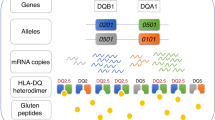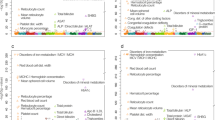Abstract
Classes I and II human leukocyte antigens (HLA) genes encode highly polymorphic heterodimeric glycoproteins involved in the control of immune responses. The HLA class I gene HFE seemingly no longer participates in immunity because it has lost its ability to bind peptides and it has acquired the ability to form complex with the receptor for iron-binding transferrin by regulating iron uptake by intestinal cells. Thus, it indirectly regulates immune responses too, because iron availability plays a role in specific and non-specific immune responses. The distribution of HFE polymorphisms in Sicilian centenarians and nonagenarians was studied to evaluate if HFE alleles might be represented differently in people selected for longevity. DNA samples were obtained from 106 young controls (age range from 22 to 55 years; 40 men and 66 women) and 35 elderly subjects (age range from 91 to 105 years; seven men and 28 women). Samples were typed for C282Y, H63D and S65C alleles using polymerase chain reaction and sequence specific primers. Among the young individuals, none was heterozygous for the C282Y or for S65C mutation. Twenty-six were heterozygous for H63D mutation. Among the elderly subjects, 11 were heterozygous for the C282Y mutation or for H63D mutation. None was heterozygous for the S65C mutation. No compound heterozygous individuals (C282Y/H63D) were found. A highly significant difference was observed in frequencies of C282Y alleles between the young and the elderly subjects on the whole. By analysing polymorphisms according to gender, heterozygous subjects for C282Y were found both in old men and in old women, but by comparing the allele frequencies to those of young people significance was attained only in women. Concerning H63D polymorphisms, no significant differences were observed, between old and young people, both in men and in women. Possession of C282Y allele, known to be associated with an increase of iron uptake, significantly increases women possibility to reach longevity. Thus, present data adds another piece of evidence to the complex puzzle of genetic and environmental factors involved in control of lifespan expectancy in humans.
This is a preview of subscription content, access via your institution
Access options
Subscribe to this journal
Receive 6 digital issues and online access to articles
$119.00 per year
only $19.83 per issue
Buy this article
- Purchase on Springer Link
- Instant access to full article PDF
Prices may be subject to local taxes which are calculated during checkout
Similar content being viewed by others
References
Candore G, Lio D, Colonna Romano G, Caruso C . Pathogenesis of autoimmune diseases associated with 8.1 ancestral haplotype: effect of multiple gene interactions Autoimmun Rev 2002 1: (in press)
Caruso C, Candore G, Colonna Romano G et al. Immunogenetics of longevity. Is major histocompatibility complex polymorphism relevant to the control of human longevity? A review of literature data Mech Ageing Dev 2001 122: 445–462
Feder JN, Gnirke A, Thomas W et al. A novel MHC class I-like gene is mutated in patients with hereditary haemochromatosis Nat Genet 1996 13: 399–408
Klein J, Sato A . The HLA system. Second of two parts N Engl J Med 2000 343: 782–790
Salter-Cid L, Brunmark A, Peterson PA, Yang Y . The majorhistocompatibility complex-encoded class I-like HFE abrogates endocytosis of transferrin receptor by inducing receptor phosphorylation Genes Immun 2000 1: 409–417
Salter-Cid L, Peterson PA, Yang Y . The major histocompatibility complex-encoded HFE in iron homeostasis and immune function Immunol Res 2000 22: 43–59
Oppenheimer SJ . Iron and its relation to immunity and infectious disease J Nutr 2001 131: 616S–633S
Kuvibidila SR, Porretta C, Baliga BS . Iron deficiency alters the progression of mitogen-treated murine splenic lymphocytes through the cell cycle J Nutr 2001 131: 2028–2033
Waheed A, Parkkila S, Zhou XY et al. Hereditary hemochromatosis effects of C282Y and H63D mutations on association with beta-2-microglobulin, intracellular processing, and cell surface expression of the HFE protein in COS-7 cells Proc Nat Acad Sci 1997 94: 12384–12389
Bassett ML, Halliday JW, Brittenham GM . Genetic haemochromatosis Sem Liver Dis 1994 4: 217–227
Mura C, Raguenes O, Ferec C . HFE mutations analysis in 711 hemochromatosis probands evidence for S65C implication in mild form of hemochromatosis Blood 1999 1593: 2502–2505
Rochette J, Pointon J, Fisher J et al. Multicentric origin ofhemochromatosis gene (HFE) mutations Am J Hum Genet 1999 64: 1056–1062
Campo S, Restuccia T, Villari D et al. Analysis of haemochromatosis gene mutations in a population from the Mediterranean Basin Liver 2001 21: 233–236
Chang JG, Liu TC, Lin SF . Rapid diagnosis of the HLA-H gene Cys 282 Tyr mutation in hemochromatosis by polymerase chain reaction a very rare mutation in the Chinese population Blood 1997 89: 3492–3493
Fabrega E, Castro B, Sanchez-Castro L, Benito A, Fernandez-Luna JL, Pons-Romero F . The prevalence of the Cys282Tyr mutation in the hemocromatosis gene in Cantabiria in patients diagnosed with hereditary hemochromatosis Med Clin (Barc) 1999 112: 451–453
Hallberg L, Bjorn-Rasmussen E, Jungner I . Prevalence of hereditary hemochromatosis in two Swedish urban areas J Intern Med 1989 225: 249–255
Jonsson JJ, Johannesson GM, Sigfusson N, Magnusson B, Thjodleiffson B, Magnusson S . Prevalence of iron deficiency and iron overload in the adult Icelandic population J Clin Epidemiol 1991 44: 1289–1297
Karlsson M, Ikkala E, Reunanen A, Takkunen H, Vuori E, Makinen J . Prevalence of hemochromatosis in Finland Acta Med Scand 1988 224: 385–390
Papanikolaou G, Politou M, Terpos E, Fourlemadis S, Sakellaropoulos N, Loukopoulos D . Hereditary hemochromatosis HFE mutation analysis in Greeks reveals genetic heterogeneity Blood Cells Mol Dis 2000 26: 163–168
Pozzato G, Zorat F, Nascimben F et al. Haemochromatosis gene mutations in a clustered Italian population: evidence of high prevalence in people of Celtic ancestry Eur J Hum Genet 2001 9: 445–451
Ryan E, O’Keane C, Crowe J . Hemochromatosis in Ireland and HFE Blood Cells Molecules Dis 1998 24: 428–432
Smith BN, Kantrowitz W, Grace ND et al. Prevalence of hereditary hemochromatosis in a Massachusetts Corporation is Celtic origin a risk factor? Hepatology 1997 25: 1439–1446
Sohda T, Yanai J, Soejima H, Tamura K . Frequencies in the Japanese population of HFE gene mutations Biochem Genet 1999 37: 63–68
Velati C, Piperno A, Fargion S, Colombo S, Fiorelli G . Prevalence of idiopathic hemochromatosis in Italy study of 1301 blood donors Haematologica 1990 74: 525–530
Dawkins R, Leelayuwat C, Gaudieri S et al. Genomics of the major histocompatibility complex: haplotypes, duplication, retroviruses and disease Immunol Rev 1999 167: 275–304
Simon M, Alexandre JL, Fauchet R, Genetet B, Bourel M . The genetics of hemochromatosis Prog Med Genet 1980 4: 135–168
Merryweather-Clarke AT, Pointon JJ, Shearman JD, Robson KJH . Global prevalence of putative haemochromatosis mutations J Med Genet 1997 34: 275–278
Remacha AF, Barcelo MJ, Sarda MP, Blesa I, Altes A, Baiget M . The S65C mutation in Spain. Implications for iron overload screening Haematologica 2000 85: 1324–1325
Oberkanins C, Moritz A, de Villiers JN, Kotze MJ, Kury F . A reverse-hybridization assay for the rapid and simultaneous detection of nine HFE gene mutations Genet Test 2000 4: 121–124
Camaschella C, Roetto A, Cali A et al. The gene TFR2 is mutated in a new type of haemochromatosis mapping to 7q22 Nat Genet 2000 25: 14–15
Conte D, Manachino D, Colli A et al. Prevalence of genetic hemochromatosis in a cohort of Italian patients with diabetes mellitus Ann Intern Med 1998 128: 370–373
Fargion S, Fracanzani AL, Romano R et al. Genetic hemochromatosis in Italian patients with porphyria cutanea tarda possible explanation for iron overload J Hepatol 1996 24: 564–569
Sampietro M, Caputo L, Casatta A et al. The hemochromatosis gene affects the age of onset of sporadic Alzheimer’s disease Neurobiol Aging 2001 22: 563–568
Moalem S, Percy ME, Andrews DF et al. Are hereditary hemochromatosis mutations involved in Alzheimer disease? Am J Med Genet 2000 393: 58–66
Bulaj ZJ, Griffen LM, Jorde LB, Edwards CQ, Kushner JP . Clinical and biochemical abnormalities in people heterozygous for hemochromatosis N Engl J Med 1996 335: 1799–1805
Beutler E, Felitti V, Gelbart T, Ho N . The effect of HFE genotypes on measurements of iron overload in patients attending a health appraisal clinic Ann Intern Med 2000 133: 329–337
Collins HL, Kaufmann SHE . The many faces of host responses to tuberculosis Immunology 2001 103: 1–9
Herskind AM, Mcgue M, HoIm NV, Sorensen TIA, Harvald B, Vaupel JW . The heritability of human longevity a population-based study of 2872 Danish twin pairs born 1870–1900 Hum Genet 1996 97: 319–323
Ljungquist B, Berg S, Lanke J, McClearn GE, Pedersen NL . The effect of genetic factors for longevity a comparison of identical and fraternal twins in the Swedish Twin Registry J Gerontol A Biol Sci Med Sci 1998 53: M441–M446
Schachter F, Cohen D, Kirkwood T . Prospects for the genetics of human longevity Hum Genet 1993 91: 519–526
Mack Smith D . A history of Sicily. Medieval Sicily 800–1713. Modern Sicily after 1713 Chatto and Windus: London 1968
Robine JM, Kiirkwood TBL, Allard M . Sex and Longevity. Sexuality, Gender, Reproduction, Parenthood Springer-Verlag: Berlin 2001
Franceschi C, Motta L, Valensin S et al. Do men and women follow different trajectories to reach extreme longevity? Italian Multicenter Study on Centenarians Aging (Milan) 2000 12: 77–84
Bonafè M, Olivieri F, Cavallone L et al. A gender-dependent genetic predisposition to produce high levels of IL-6 is detrimental for longevity Eur J Immunol 2001 31: 2357–2361
Lio D, Scola L, Crivello A et al. Allele frequencies of +874T→A single nucleotide polymorphism at the first intron of Interferon-γ gene in a group of Italian centenarians Exper Gerontol 2002 37: (in press)
Lio D, Scola L, Crivello A et al. Gender-specific association between −1082 IL-10 promoter polymorphism and longevity Genes Immun 2002 3: 30–33
Shorter E . A History of Women’s Bodies Basic Books, Inc: New York 1982
Miller SA, Dykes DD, Polesky HF . A simple salting out procedure for extracting DNA from human nucleated cells Nucl Acid Res 1988 16: 1215
Takeuchi T, Soejima H, Faed JM, Yun K . Efficient large-scale screening for the hemochromatosis susceptibility gene mutation Blood 1997 90: 2848–2849
Mullighan CG, Bunce M, Fanning GC, Marshall SE, Welsh KI . A rapid method of haplotyping HFE mutations and linkage disequilibrium in a Caucasoid population Gut 1998 42: 566–569
Author information
Authors and Affiliations
Corresponding author
Additional information
These studies have been supported by grants from MURST, Rome (ex 40%, Immunogenetics of Longevity, coordinated by Professor Calogero Caruso, to CC and DL), ex 60% to CC and GC, from Ministery of Health Project “Pharmacogenomics of Alzheimer’s Disease” and by a cooperation contract between the Dipartimento di Biopatologia e Metodologie Biomediche dell’Università di Palermo and the Istituto Nazionale di Riposo e Cura per Anziani di Ancona (Longevity and elderly disability biological markers).
Rights and permissions
About this article
Cite this article
Lio, D., Balistreri, C., Colonna-Romano, G. et al. Association between the MHC class I gene HFE polymorphisms and longevity: a study in Sicilian population. Genes Immun 3, 20–24 (2002). https://doi.org/10.1038/sj.gene.6363823
Received:
Revised:
Accepted:
Published:
Issue Date:
DOI: https://doi.org/10.1038/sj.gene.6363823
Keywords
This article is cited by
-
The mechanisms of systemic iron homeostasis and etiology, diagnosis, and treatment of hereditary hemochromatosis
International Journal of Hematology (2018)
-
Evidence from case–control and longitudinal studies supports associations of genetic variation in APOE, CETP, and IL6 with human longevity
AGE (2013)
-
Genetics of longevity. Data from the studies on Sicilian centenarians
Immunity & Ageing (2012)
-
Evolutionary explanations in medical and health profession courses: are you answering your students' "why" questions?
BMC Medical Education (2005)
-
Reproduction and migration in relation to senescence in the barn swallow Hirundo rustica: A study of avian ‘centenarians’
AGE (2005)



